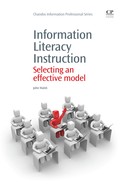Introduction
In their 1989 Final Report, the ALA’s Presidential Committee on Information Literacy called information literacy a ‘survival skill.’ This is even more true two decades later as technology has changed library participants’ knowledge acquisition behavior. Participants now acquire their information from the Internet and information literacy is essential when using the Internet as a research tool. Library participants are acquiring knowledge from a medium in which anyone can write anything they want, true or false, anonymously and without consequences. This method of acquisition is threatening the epistemological protection librarians have long been providing. There is a variety of successful methods available for information literacy instruction: as Grassian and Kaplowitz claim, a ‘smorgasbord groaning with an array of choices.’ (Grassian and Kaplowitz, 2001). Choosing from the extensive menu can be work intensive and time consuming. There are so many factors to consider when choosing a method, topics, contact times, and delivery modes available. These elements can be blended in any number of ways, making a decision even more challenging. Then there are the tangible and intangible factors to consider: audience, purpose (what is the objective of the program), cost, time, staff, equipment, software, facilities, materials, preparation time, stakeholder impact, participants’ availability (Grassian and Kaplowitz, 2009) – all of this before considering the effectiveness of the method. Being without information literacy skills can be serious and the consequences can affect quality of life. Full participation in this information rich society requires a high level of information literacy (Gross and Latham, 2007). Librarians are the leaders in the movement for an information literate society and should be effective in providing instruction that teaches these skills. There is no one proven method that is considered most effective for ILI; the existing methods are effective in different environments and situations. This book provides practical advice to librarians and others who want to select an effective information literacy instructional method for their ILI program.
References
Association of Research and College Libraries (1989) Presidential Committee on Information Literacy: Final Report. Available at http://www.ala.org/ala/mgrps/divs/acrl/publications/whitepapers/presidential.cfm#importance.
Grassian, E., Kaplowitz, J. Information Literacy Instruction: Theory and Practice, second edition. New York, NY: Neal-Schuman; 2001.
Gross, M., Latham, D. Attaining information literacy: An investigation of the relationship between skill level, self-estimates of skill, and library anxiety. Library and Information Science Research. 2007; 29:332–353.
Meyer, K.R., Hunt, S.K., Hopper, K.M., Thakkar, K.V., Tsoubakopoulos, V. and Van Hoose, K.J. Assessing Information Literacy Instruction in the Basic Communication Course, Communication Teacher, 22(1): 22–34.
